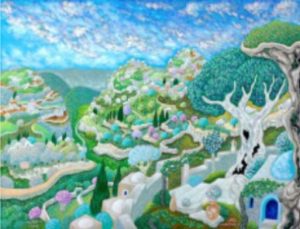By Rabbi Moshe Goodman, Kollel Ohr Shlomo, Hebron
בס”ד
לשכנו תדרשו
Discover the Holy Presence in Our Holy Land
The Source of Blessing

Comparing this painting, which Nachshon attached to parshat Behukotai, to that of the previous painting we discussed that Nachshon attached to parshat Behar, we see that here there are many more signs of human habitation in the form of houses, jars, walls, etc. versus the Behar painting which was very rural. Indeed, parshat Behar puts much emphasis on the Holy Land itself, while parshat Behukotai puts greater emphasis on Israel’s habitation in this Land – will it be allowed with a blessing or, God forbid, uprooted in exile and its curses.
We see a house, its surrounding wall, and a tree within these walls take a dominant place in this painting. We see that the tree has seven branches, a favorite number in all of Nachshon’s paintings. Three branches even form the letter shin, a symbol for the Divine Name Shadai, symbolizing the Divine Guidance, as is famously known in the mezuza, in many of Nachson’s paintings. The stem of the tree has three holes, causing the stem to be divided into three parts. This seems to echo the Kabbalistic teaching we also mentioned last week, of seven sefirot versus another three sefirot, considered to be the “stem” or “source” of these seven sefirot. We see that the house has white and blue colors which are the same colors of the tzitzit and techelet dye, which are meant to remind us of the Divine commandments. Also, this parsha teaches us that through fulfilling these commandments we will indeed be able to inhabit the Land successfully. It seems that this habitation is symbolized by this house depicted in these colors. (By the way, in Tzfat, houses are colored blue similar to the house here.) There are three grapevines that may hint at the three grapes in the Wine-officers’ dream as told to Yosef. These grape vines are interpreted by our Sages to also hint to the People of Israel. It is known that the People of Israel have three ancestral roots, the Patriarchs of Hebron, Avraham, Yitzhak, and Yakov. Also note that there are also three jars, which may signify that just as there are three sources of sustenance symbolized by the three vines, so too thetre are three vessels to receive this sustenance, thus showing a sign of blessing not only in potential but also realized and received. We also see 4 Stairs like the painting we saw in parshat Chayei Sara where we discussed their significance in the context of the four Kabbalistic worlds, “built” one upon the other. There are four crevices/steps in the wall to the left and three of these to the right, altogether seven, the famous number, which we divided into two parts last week, corresponding to the three Patriarchs and the four Matriarchs.
These themes, of course, reflect Hebron, the first settlement of our People in the Holy Land, a symbol of Israel’s blessing of settlement in the Holy Land in the past, the present, and ultimately the future everlasting in Israel’s shining future.



